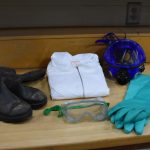Let’s start to learn Soap Making at Home in Pakistan. Soap making is the process of creating soap from a combination of fats or oils and an alkali, typically sodium hydroxide (lye) or potassium hydroxide. The chemical reaction between these ingredients, known as saponification, produces soap.

Here’s a basic overview of the soap making process:
Gather your ingredients:
You’ll need fats or oils, such as coconut oil, olive oil, or shea butter, and an alkali (sodium hydroxide or potassium hydroxide). You may also choose to add fragrance oils, essential oils, colorants, or other additives for customization.
Calculate the quantities:
To create a successful batch of soap, you need to measure the precise amounts of oils and alkali. You can use soap calculators available online to determine the correct proportions based on the specific ingredients you’re using.
Safety precautions: 
Soap making involves working with caustic chemicals, so it’s essential to take safety precautions. Wear protective gear such as goggles, gloves, and a long-sleeved shirt. Work in a well-ventilated area and keep vinegar nearby to neutralize any spills or splashes of lye.
Melt the oils:
Heat the oils in a large stainless-steel pot or a heat-resistant container until they’re fully melted and well-combined.
Prepare the lye solution:
Dissolve the lye (sodium hydroxide or potassium hydroxide) in water. It’s important to add the lye to the water slowly and stir continuously to avoid splattering. This mixture will heat up, so allow it to cool down to around 100°F (38°C).
Combine the lye solution and oils:
Slowly pour the lye solution into the melted oils while stirring continuously. This process is called “saponification.” Use a stick blender or mixer to blend the mixture until it reaches a trace, a stage where the mixture thickens to the consistency of a light custard.
For Good Soap Making Add additives: 
If desired, add fragrance oils, essential oils, colorants, or other additives to the soap mixture. Stir them in thoroughly.
Pour into molds:
Pour the soap mixture into molds, which can be silicone molds or lined wooden molds. Tap the molds gently to remove any air bubbles and smooth the surface.
Insulate and cure:
Cover the molds with a towel or plastic wrap to insulate them and retain heat. Allow the soap to cure for about 24 to 48 hours. Afterward, remove the soap from the molds and let it cure further for several weeks in a cool, dry place. Curing allows the soap to harden and any excess moisture to evaporate, resulting in a milder and longer-lasting soap.
Enjoy your handmade soap:
Once the soap has cured, it’s ready to be used or gifted. Remember to test a small amount of the soap on your skin to ensure you don’t have any adverse reactions before using it regularly.
Conclusion
Soap making at home in Pakistan can be a creative and rewarding hobby. However, it’s important to research and follow proper safety procedures and understand the chemistry involved to ensure you make soap safely and effectively. If you want to know the Soap Making Machine Price in Pakistan you should visit our website or just contact with us at 03196339721. Address is Noor Baaf Engineering, Awan Chowk, Opposite PSO Pump, Khanewal.
FAQs
Is soap making at home in Pakistan safe?
Soap making involves working with caustic substances such as lye, which can be dangerous if mishandled. However, if you follow proper safety precautions, use protective gear, and handle the ingredients carefully, soap making can be done safely. Always research and understand the process before starting, and work in a well-ventilated area.
Can I make soap without lye?
No, you cannot make traditional soap without an alkali such as lye. The chemical reaction between fats/oils and lye is essential for saponification, the process that creates soap. However, there are alternative methods like melt-and-pour soap bases or rebatching, which involve pre-made soap that has already gone through the saponification process.
Can I use any oil or fat to make soap?
Different oils and fats have different properties, and they can affect the final characteristics of the soap. Common oils used in soap making include coconut oil, olive oil, palm oil, shea butter, and more. It’s important to research the properties of oils and experiment with different combinations to achieve the desired soap qualities.
Can I add fragrances or colors to my soap?
Yes, you can add fragrances, essential oils, colorants, and other additives to customize your soap. It’s important to use skin-safe and soap-stable additives. Essential oils and fragrance oils should be added at a safe percentage according to guidelines, and colorants should be specifically formulated for soap making.
Can I sell the soap I make?
Yes, you can sell the soap you make, but regulations and requirements may vary depending on your location. It’s important to research and comply with local laws and regulations related to soap making and selling. This may include labeling requirements, ingredient disclosures, and proper testing.
